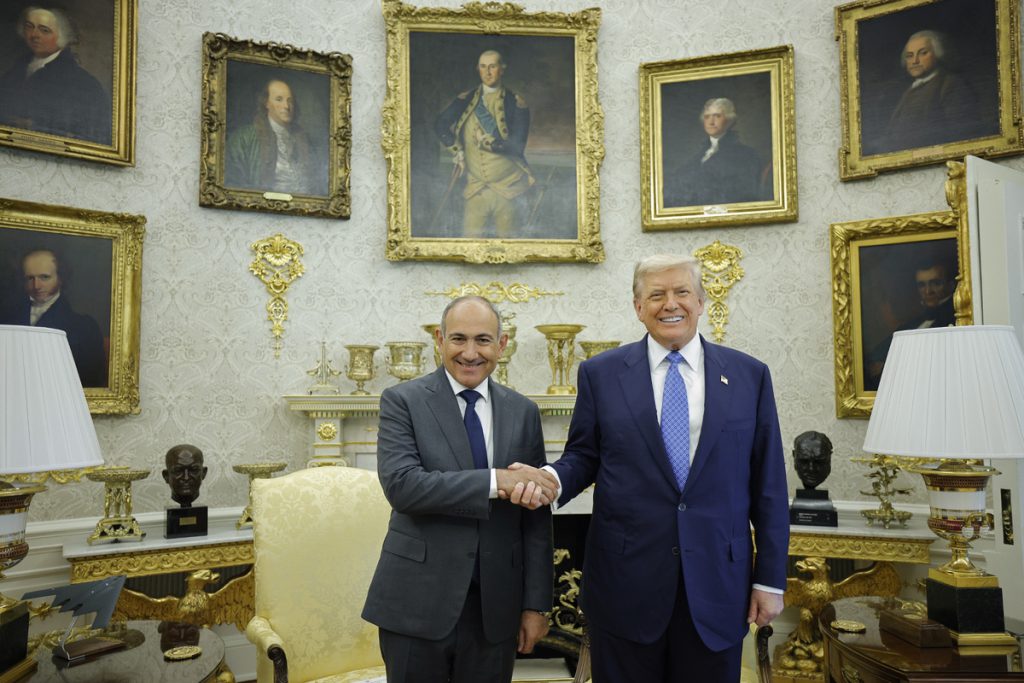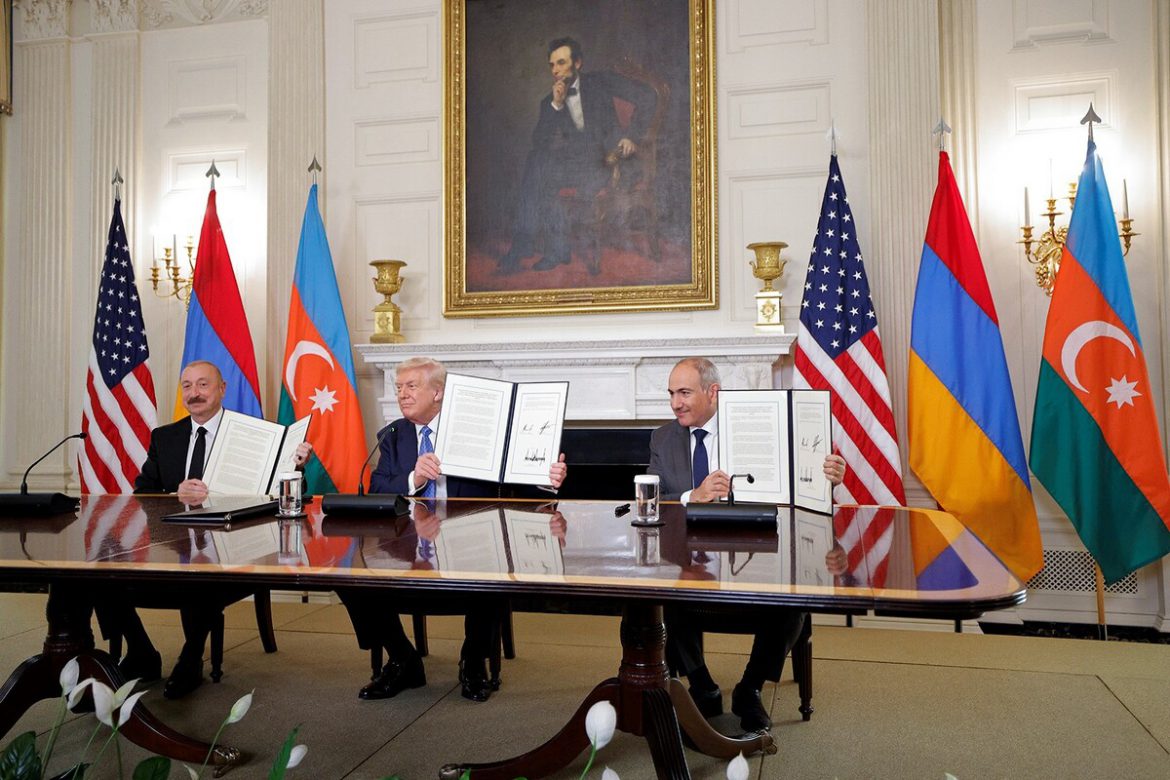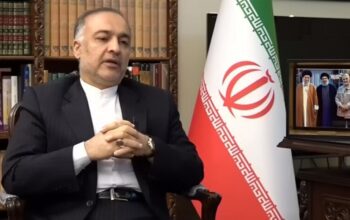By Andranik Aboyan
The White House photograph is the simplest thing to digest: three leaders, three smiling signatures, the familiar gloss of ceremonial closure. But what was placed on the table in Washington was not a full, operational treaty; it was a declaration — a public gesture whose single operative article records that the foreign ministers have initialed a draft peace agreement. The initialing is a step. It is not the law. The text of the underlying deal, which would determine who controls routes and revenues, was kept out of view pending later publication. That secrecy matters. It is the first thing the cameras are meant to hide.
We and President Donald J. Trump of the United States of America witnessed the initialing of the agreed upon text of the Agreement on Establishment of Peace and Inter-State relations between the Republic of Azerbaijan and the Republic of Armenia by the Ministers of Foreign Affairs of the Parties. In this respect, we acknowledged the need to continue further actions to achieve the signing and ultimate ratification of the Agreement, and emphasized the importance of maintaining and strengthening peace between our two countries;
Joint Declaration by the President of the Republic of Azerbaijan, the Prime Minister of the Republic of Armenia and the President of the United States of America on the outcomes of their meeting in Washington D.C., United States of America
The second thing the cameras hid is infrastructural fact. Armenia’s rail network is run by South Caucasus Railway, a company that is a wholly-owned subsidiary of Russian Railways. That is not a rhetorical point; it is the material condition through which any transit corridor must move. Tracks, timetables, signal posts, rolling stock — these are concrete levers of control. You cannot paper over who owns the rails with a press release. If a corridor is to function, the legal and operational framework that governs the existing rails must be reconciled with whatever new arrangement the declaration contemplates; otherwise implementation will be fundamentally constrained.
Taken together, those two facts — secrecy around the core treaty text and the railway’s ownership — produce a chain of predictable problems, and not only technical ones. Economist Hayk Farmanyan has warned bluntly about one immediate legal consequence: if Azerbaijani goods are allowed to transit Armenian territory without Armenian registration and customs control, that would violate the Eurasian Economic Union’s single-customs-territory regime. The EAEU’s legal architecture does not tolerate extrajudicial transit regimes that bypass the common customs rules; customs revenues and the integrity of the single market are not incidental niceties, they are the union’s operating logic. If Armenia permits uncontrolled transit, it risks not only revenue loss but the political consequence of placing itself at odds with the bloc that still structures much of its trade.
That is the logic the picture-perfect handshake paperwork erases. A political theater presents an image of reconciliation; the material and legal facts present a vector for economic displacement. The corridor’s real function, once one strips away the press-statement euphemisms, is to re-route wealth, jurisdiction and influence away from Eurasian multilateral frameworks and into new, Western-oriented conduits. The U.S. carrots — the AI/semiconductor deals, the energy security MoU, the Crossroads of Peace capacity project — are not innocuous development packages. They are instruments of re-formatting: they aim to reconfigure state capacity, technical infrastructures and elite ties so that Armenia’s future economic logic aligns with Western capital rather than with existing Eurasian arrangements.

Look at who benefits. Azerbaijan secured not only the diplomatic legitimacy of transit but concrete moves that open it to deeper U.S. partnership: reported executive action to suspend Section 907 of the Freedom Support Act (removing long-standing constraints on defense and security cooperation with Baku) and corporate deals such as the memorandum between SOCAR and ExxonMobil. These are not symbolic. They institutionalize new patterns of energy investment and security cooperation that deepen Baku’s leverage while atomizing Armenia’s negotiating position.
That asymmetry is geopolitically devastating for Armenia. If the EAEU’s fiscal and legal protections are hollowed out by extraterritorial transit, Armenia’s options shrink to two bleak alternatives: submit to a Western-led economic orbit (conditional, debt-laden, and corporate-driven), or attempt to resist and face punitive isolation within its regional economic structures. Either way, the existential pretense of choice dissolves; the horizon of alternatives narrows until there is simply “how the market will let us live.”
Russia’s reaction should have been a gusher of protest; instead it was muted, bureaucratic and strategically calibrated. The Russian Foreign Ministry’s spokeswoman offered an account that reminded everyone the 2020 trilateral framework began with Russia’s mediation — not a rebuttal to U.S. advances. That soft, managerial response is chilling, not because it signals weakness but because it reveals how influence has become a matter of backstage agreements and tolerated rearrangements. If Moscow does not openly block this initiative, it is not because it is impotent but because the new distribution of interest can be tolerated or compensated elsewhere.
This is how imperial process works now: a series of contractual enclosures presented as benevolent partnerships. The promise to “modernize” Armenia with semiconductors, AI labs and energy deals is not an unalloyed good. Without binding guarantees over who controls transit, who retains customs revenue, and who adjudicates disputes, these promises are the kind of high-tech frosting that masks a slow erosion of sovereignty. The Crossroads of Peace capacity project and the tech MoUs will rewire bureaucratic practices, training cadres in Western regulatory languages and linking elites into Western corporate networks — which is one reason these MoUs function as strategic levers rather than mere development initiatives.
Nor is this only about states. Look at the Exxon–SOCAR memorandum. When corporate interests arrive with signed MoUs and investment memoranda, they create economic constituencies that lobby for the political conditions they need. Once a multinational’s capital is parked in a project, political momentum accumulates behind legal exemptions and operational corridors that privilege their returns. Capital crowds out alternative choices before the public has even parsed the consequences.
If you strip away the rhetoric of “connectivity” and “modernisation,” the practical stakes are simple and actionable. Implementation will hinge on four technical points: (1) who inspects and registers cargo at the start and end of each transport leg; (2) how customs revenue is collected, audited and shared; (3) what legal forum arbitrates disputes; and (4) who physically controls the operating assets. Until those points are specified in legally binding text — and until that text is published for parliamentary and public scrutiny — the “peace” on a certificate risks being a corridor on the map that doesn’t run in reality.
Practical checklist for turning the photograph into a functioning, arrangement
- Publish the full texts — immediately. No implementation until the initialed agreement and all MoUs are public and translated into Armenian and English for parliamentary review. (Transparency prevents entrenchment.)
- Customs-sovereignty clause (non-negotiable). Any corridor use must require Armenian registration and physical inspection of goods at entry/exit points under Armenian customs law; manifests must be submitted to Armenian customs with real-time electronic verification.
- Revenue escrow & audit. Tariff revenues derived from corridor traffic go first into an independent escrow account administered by a tri-partite trustee (Armenian Treasury + EAEU observer + independent auditor) with published, quarterly audits.
- Railway operational protocol. Any use of South Caucasus Railway infrastructure must be governed by a published Access and Operation Agreement, signed by Armenian regulatory authorities, specifying: (a) who controls timetables and rolling stock allocation; (b) staff nationality quotas; (c) on-site Armenian customs officers; and (d) a maximum concession length (no 99-year giveaways).
- EAEU conformity & dispute resolution. The agreement must include an explicit, time-bound protocol for harmonizing corridor operations with EAEU customs law and a binding arbitration path (EAEU Court / UNCITRAL) for disputes
- MoU conditionalities. Tech and energy MoUs must include: IP-sharing thresholds, local joint venture requirements (majority Armenian ownership for critical functions), workforce training commitments, performance bonds, and clawback clauses if job/transfer targets aren’t met.
- Independent Impact Assessment. Before any ground works, commission an independent economic, environmental and social impact assessment (public) and make continuation conditional on its findings.
- Parliamentary ratification & civic oversight. No implementation steps without parliamentary ratification and creation of a multi-stakeholder oversight body (parliamentarians, independent economists, civil society and diaspora experts) empowered to halt implementation if red-flags appear.
We should be appalled not only at the content of this deal, but at the fact that the conditions for it were allowed to ripen without resistance. That it feels “inevitable” is the surest sign that the work of soft coercion has already been done — the war, the blockades, the economic starvation, all rearranged into the common sense of “normalization.” This is not peace, it is the management of dependency with a friendlier font. That the corridor’s terms can be hidden from the public, that foreign corporate signatures are inked before domestic sovereignty is secured, that infrastructure owned elsewhere can be passed off as a national lifeline — these are not accidents. They are the grammar of a system in which nations are not participants but terrain. We arrived here by mistaking the absence of open conflict for the presence of autonomy, and by the time we notice the map has been redrawn, we are already living inside it.




